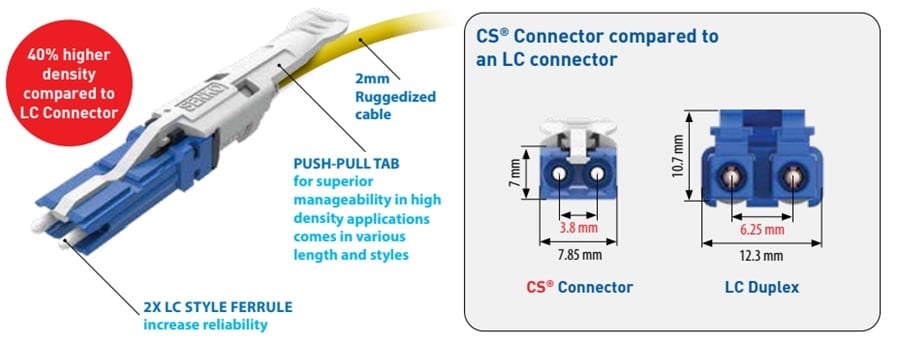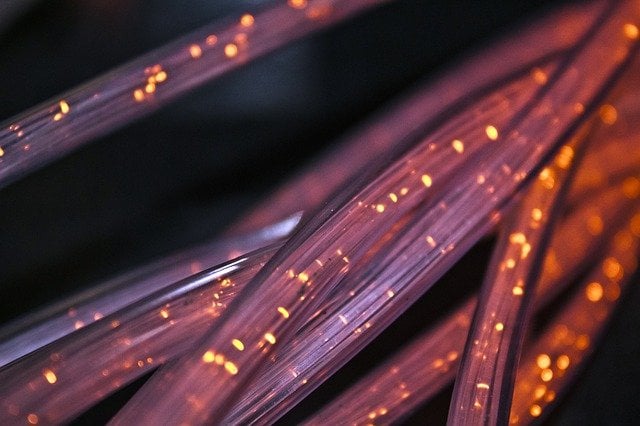Network Cabling
Understanding CS Connector for Fiber Patch Cable: A Beginner Guide
Along with the dramatic increase in network bandwidth requirements, data centers have adopted 100Gb backbones on a large scale and upgraded to higher speed 200Gb and 400Gb backbones hyper-scale data centers. In this context, the SENKO-led standards organization created a new CS connector specification that increases the number of duplex optical links. The purpose of this organization is to provide a next-generation, high-density CS connector that supports data rates up to 400Gb/s. This article will give a beginner guide to understanding CS connectors for fiber patch cables.
CS Connector Basics
CS connector is a new generation of high-density, very small form factor (VSFF) optical connector excellent for small-space high-density solutions. CS connectors provide significant space savings of ~40% over LC and other optical connectors. Compared to an LC duplex connector, the CS connector allows you to twice the density of patch panels. It allows for more fantastic cable management space and improved performance than the LC connector. The CS connector features Push/Pull tab for improved high-density application usability. CS connectors are available in single-mode (SM) and multimode (MM) versions.

CS Connector Transceiver Applications
Most traditional optical transceiver modules like XFP, SFP/SFP+, QSFP, QSFP28, and QSFP-DD use LC connectors. CS connector optical transceivers offer the same functionality as traditional optical modules. Still, they provide significantly higher density and lower total cost of ownership (TCO). Below is a list of some high-speed optical transceivers that use CS connectors.
- 200G QSFP-DD Transceiver with 2x CS connector (2x100G)
- 400G OSFP Transceiver with 2x CS connector (2x200G)
- 800G QSFP-DD Transceiver with 2x CS connector (2x400G)
Some other 200G/400G transceivers also use traditional LC connectors for single mode type, MPO/MTP connectors for multimode, and parallel single mode fiber type.
CS Connector for Fiber Patch Cable
- CS-CS Single Mode Fiber Patch Cable: Terminated with Senko CS connector on two ends, the CS-CS single mode fiber patch cable is suitable for next-generation 200/400G transceiver QSFP-DD and OSFP with CS connectors, such as CWDM4, FR4, LR4, and SR2.
- LC-CS Single Mode Fiber Patch Cable: Terminated with Senko CS connector on one end and LC connector on another end, this LC-CS Single Mode Fiber Patch Cable is suitable for connecting the CS connector to typical LC-based patch panels, and cabling systems are possible with these single-mode hybrid cables.
FAQs About CS Connector
Q1: What Are the Advantages of CS Connector?
The CS connector has higher density and durability than LC and SC connectors. It is a good choice if you need a rugged, space-saving optical fiber connection.
Q2: What is the difference between the CS connector and SN connector?
The SN connector is an improved version of the CS connector. The SN provides a double density as CS and has a more compact design.
Final Words
The CS connector is the next-generation, high-density CS connector that supports data rates up to 400Gb/s and 800Gb/s. CS connectors provide significant space savings of ~40% over LC optical connectors. It is an excellent choice for small-space high-density solutions. We hope you find this article helpful in your journey of CS connector understanding. If you have any further questions, please feel free to contact us.
Read more:
- Terabit BiDi MSA Overview: A Beginner Guide
- 400G Optical Transceiver Overview: A Beginner Guide
- What you need to know about Optcore 400G QSFP-DD DAC Cables
Reference:
- Senko White Paper: CS® – the Next Generation connector for 200G/400G Deployments
- http://csconnector.net/








Hi Lisa, we will be scoping CS fibres in the next few weeks with Viavi Fibrechek Pro scopes. Do we need a specific tip to scope them? Ive used an LC/UPC tip and get a clear pic of a single round end. Is there a reason this wont be OK? Thanks in advance.